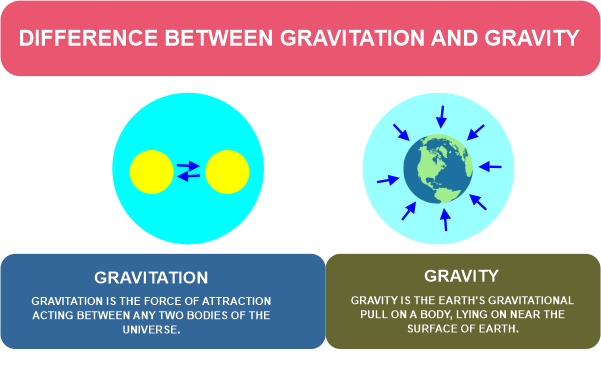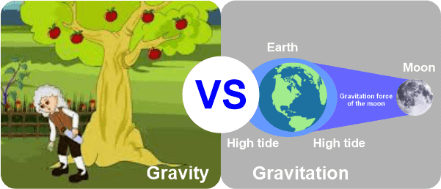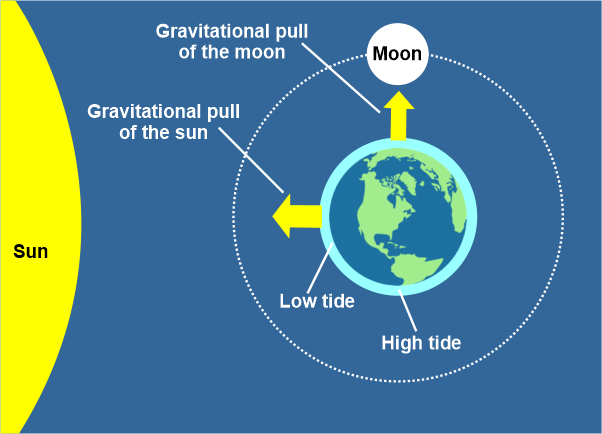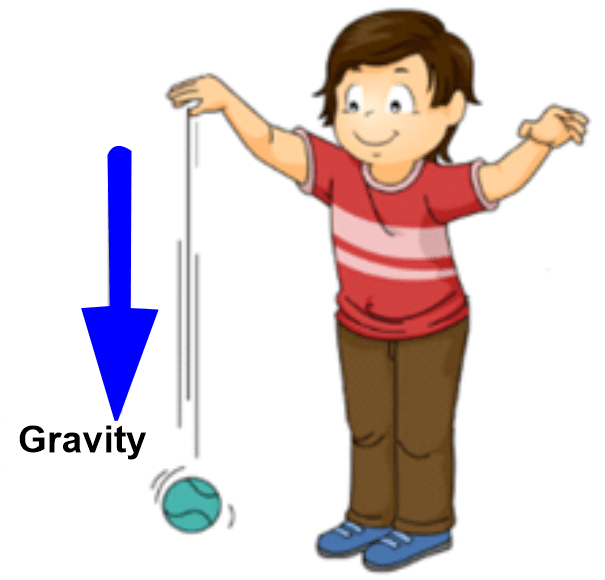Difference Between Gravity And GravitationIn accordance with the universal law of gravitation, the terms gravity and gravitation define the circumstance that allows masses to be drawn together. Both names can be used interchangeably with ease. Despite the fact that the words gravity and gravitation are commonly being used in Physics, their underlying concepts are not necessarily the same. Since the two concepts are a little ambiguous, people occasionally understand them incorrectly and mistake them for one another. However, gravitation differs from gravity in a number of ways. 
The force acting on a body that is on the earth's surface is referred to as gravitation and gravity, respectively. Gravity and gravitation are fundamentally different from one another since gravitation is linked to items existing in the cosmos. However, only when a body is on the surface of the earth does gravity apply precisely. The force that holds something in place against the surface of the earth is called gravity. In most circumstances, these two terms are used interchangeably. Even though these two-sound identical, there is a difference between them. GravityGravity is one of the four basic forces that govern the universe, along with electromagnetism, strong and weak nuclear energy, and electromagnetic forces. All physics is based on these four fundamental forces, which also govern how other things behave in the universe, from the massive cosmic interactions between galaxies to the close connections between quarks inside an proton or neutron. 
Gravity is another natural phenomenon which acts between both the earth and any item in the cosmos. The force of gravity is the name given to the force that exists between an object and the earth when it is close by. Gravity particularly connects to the ground and all nearby objects. Similar to how we are drawn to the earth's surface, the Moon is dragged towards it by a force (F) that is directly proportional to an object's mass (M). F ∝ M It is evident that a constant term must be added to the right-hand side of the expression to transform it into an equation; in this instance, the constant term is the acceleration caused by gravity (g). Therefore, F = M×g G's constant value is 9.8 m/s2, which is rounded up to 10 m/s2 for convenience in calculations. Although not a universal constant, this acceleration brought on by gravity varies in value. It is interesting to observe how minor the gravitational force is in relation to the force of gravity. As a result, it is difficult for two objects to be attracted to or repellent to one another on the surface of the planet. Earth, however, is a strong magnet for falling objects. GravitationThe term "gravitation" refers to a natural phenomenon that results in the movement of two far-away objects in the cosmos. In accordance with the universal law of gravity, gravitation is the attracting force that unites all matter, both great and tiny. Among the basic natural interactions, it is also the least effective universal gravitational law of Newton may be used to roughly approximate gravity on either side. The law of universal gravitation was discovered by Sir Isaac Newton somewhere about 1687, and he utilized it to illustrate how the moon and planets move through space. According to Newton's Law of Universal Gravitation, every particle in the cosmos is drawn to every other particle by a force that is inversely proportional to their distance from one another and proportionally to both of their masses. We are aware that each and every body in the cosmos only moves when another force is at work. Consequently, gravitational force is the name given to the force that exists between two bodies throughout the cosmos. Let's think on the illustration below: Here, two bodies are placed apart by a distance of x, and their respective masses are m1 and m2. As a result, the force between two bodies will be expressed as: F∝ (m1×m2)r2 
where the gravitational pull between two bodies is represented by F. The masses of the two bodies are m1 & m2, respectively, and There is a r2 distance between their centers. A constant must now be doubled in order to once more equal F to right-hand side. Here, F=G.(m1m2)r2 The universal constant G has the value 6.67 X 10-11 Nm2/Kg2 in this situation. G is the only constant that exists across the cosmos; hence its value is constant everywhere. Both the mass of the bodies and the spacing between them affect the force that the bodies feel. As a result, when the bodies have big masses, there will be more force between them. The force will, however, be quite weak if the two are far apart from one another. Difference Between Gravity and GravitationGravity and gravitation are distinguished from one another by the following features: 
Another definition states that the gravitational force is a force which is inversely proportional to the square of the combined distance between two objects and directly proportional to the sum of the masses of those two objects. Most of the time, gravity is thought of as a natural phenomenon that causes objects to be drawn to the ground. The maintenance of life on earth is considered to be greatly influenced by gravity. The word gravitational pull refers to the force that keeps our planet's atmosphere, sun, and earth's atmosphere together. Because of this, breathing air is necessary for human survival. Furthermore, it aids in keeping us away from the sun and star safely. Every single item in this universe is attracted to every other thing with a particular amount of force. One of the key factors contributing to the force of attraction's weak nature is the great distances between the objects.

Each thing is subject to the identical effects of gravity. A feather and an iron rod will both fall in the same speed if we drop them both. It can appear that the iron rod is falling faster because of an external impact such as air resistance on gravity. However, they would all fall at once if we dropped them in a vacuum. A mass-based relationship exists between an object's gravity and mass. It is regarded as one among nature's weaker forces. 
Due to their frequent overlap, the two words can occasionally be used incorrectly, leading to a misconception that they are interchangeable. Let's look into the table below for further information.
In ConclusionIn physics, the terms gravitation and gravity appear to be quite similar. The two names are frequently used synonymously. Even though the terms gravitation and gravity are generally used interchangeably, there is a distinction between the two. The driving force that pulls two bodies together is gravity. Gravity is a force that exists with objects, including the enormous body known as the earth, on both sides of the equation. The term "gravitation" refers to a force that is equivalent to the sum of the mass of two objects. Most people think of gravity as the earth's inherent tendency to pull objects toward it. Therefore, based on this discussion, it may be inferred that gravity and gravitation are conceptually equivalent in that they are both defined by the force that acts between two bodies.
Next TopicDifference between
|
 For Videos Join Our Youtube Channel: Join Now
For Videos Join Our Youtube Channel: Join Now
Feedback
- Send your Feedback to [email protected]
Help Others, Please Share









